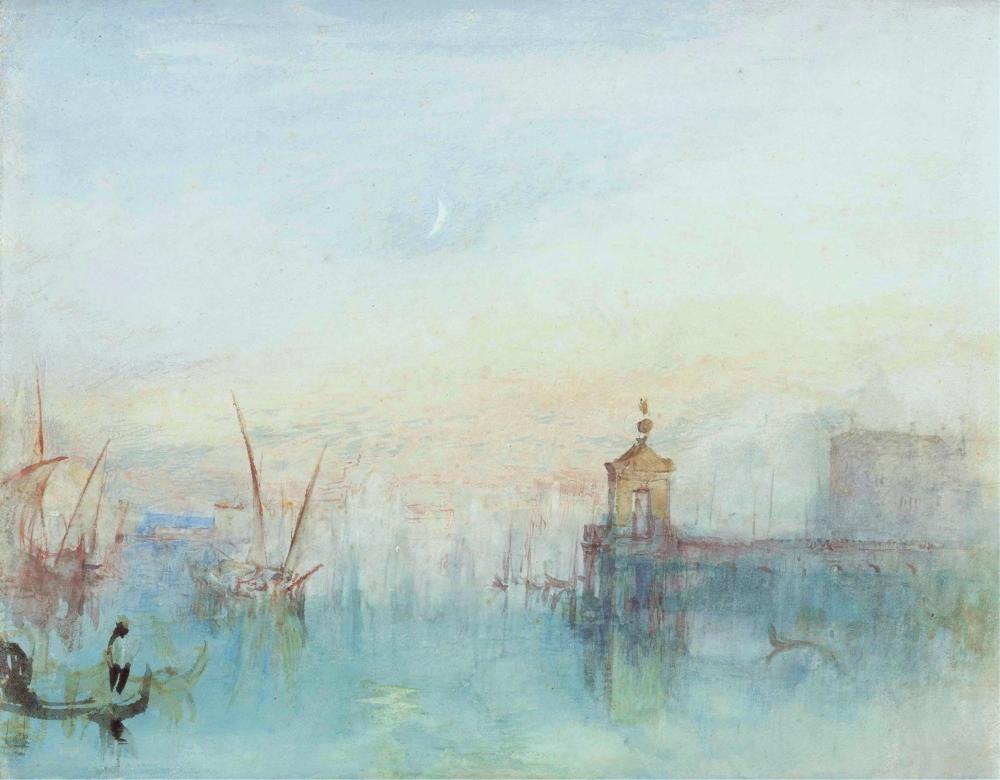WILLIAM CALLOW R.W.S.
(1812-1908)
The Grand Canal, Venice
Signed and dated: Wm. Callow 1859 (lower right)
Provenance
Leger Galleries, London, 1977
Mr. and Mrs. Eric Gross
Christie’s, 9 July 1985, lot 180
Private Collection, USA
Exhibited
London, Royal Society of Painters in Water-Colour, 1859, as ‘Grand Canal, Venice’, no. 237
Literature
Jan Reynolds, William Callow, London, 1980 p.85 (illus.)
John Herbert, Christie’s Review of the Season, London, 1985, p.175
The experts are right, he thought. Venice is sinking. The whole city is slowly dying. One day the tourists will travel here by boat to peer down into the waters, and they will see pillars and columns and marble far, far beneath them, slime and mud uncovering for brief moments a lost underworld of stone. Daphne du Maurier
Venice is sinking. About 9 inches in the last 100 years. As the city continues to settle on the caranto below, the sea continues to rise with still greater speed. A recent study has forecast the complete submergence of Venice by the year 2100. Whether or not this will come to pass, ‘the widowed daughter of ocean’ - La Serenissima, since the fall of the Napoleonic Kingdom of Italy, has embodied and engendered with greater perceptibility, twin parallel states of creation and destruction; a continuous transformation of both itself and those who journey to it, all set in striking relief amidst the slow decline and fall, ‘which we feel in walls that have long been washed by the passing waves of humanity’.
Venice, after 1100 long years of independence as a republic, began the nineteenth century and remained for much of it, adrift in the humiliating waters of vassalage. From 1797 until the Unification of Italy in 1866, Venice was alternately ruled and plundered, by both Napoleon and the Austrians. Within the first two decades of the 1800s, Venice saw its territories dispossessed through capture and revolution, its Navy scuttled, the Arsenal burned down, and its people ravaged by the consonant iniquities of disease and starvation. After the Treaty of Campo Formio in 1797, France ran off with everything which was not firmly nailed down, ‘horn salt and biscuits, tons of hemp, miles of rope, acres of canvas’ - and typically of Napoleon, the Ancient Greek bronze horses of St Mark and Cilician winged ‘Lion of Venice’, which was badly damaged when it was removed from atop its column in the Piazzetta. A total of 91 churches, monasteries and convents were demolished. The complete disestablishment of the Venetian religious and social confraternities known as ‘scuole’, which were self-run charitable institutions and integral to the city; fellowships embodying the precepts as set forth in Matthew, XXV, 31-46: ‘to feed the hungry, to give drink to the thirsty, to clothe the naked, to harbour the harbourless, to visit the sick, and to these were added the obligations to ransom the captive and bury the dead.’ - were abolished in an edict of 1806. Napoleon considering them a threat, broke up all 350 Venetian scuole, many six-hundred years old. A handful were later reformed. Under Hapsburg control the city fared little better. A period of political and social agitation cast a dark shadow over this 50-year rule, a logical and direct response to the forlorn state the city now found itself in, occasionally anti-Hapsburg dissent would spill out into uprisings, most notably, in the revolution of 1848-9. Famine and cholera pandemics (six in Venice during the nineteenth century) occurred in regular fits and starts. The physical, and social decay of, and, in Venice around the middle of the nineteenth century, all helped to hang a backdrop of disquiet over the Venetian Lagoon. It remained to be seen whether ‘the ancient city tired from having lived too long, the ravaged marble and worn out bells’ - was fated to be drowned by the sea or fractured irreversibly by the folly of man?
William Callow’s third visit to Venice in 1858 coincided with the start of Richard Wagner’s first residency in the city. Both were lifelong Venetophiles, and in much the same way as it was with Ruskin, the city was the birthplace, setting and inspiration for some of their most important compositions. Indeed, the present work is one of Callow’s most beautiful watercolours. It was last seen nearly 40 years ago when it made, at that time, one of the highest auction prices ever achieved by a William Callow watercolour. The canonical atmospheric pictures of the blue gliding ribbands of Venetian canals, as conceived by Bonington and Turner, modernised and restyled the classical vedute scenes of Guardi and Canaletto from the century before. In the early 1830s, Callow had made a close study of the works of Bonington on the advice of Thomas Shotter Boys, a former pupil of Bonington’s. Turner, who has been called ‘a hero of Callow’s’, remained for the young artist a lifelong inspiration. The present watercolour demonstrates the influence of both Bonington and Turner, particularly, in the manner in which the exercise of transcribing topography is elevated to the ‘finery of poetic extravagance’.
The theorist Roger de Piles contended that the greatest pictures are felt and understood in the very first glance: l'effet au premier coup d’oeil . This idea can be developed further by proposing that the best works are predominantly felt by the viewer in their viscera, and not as many will believe, in the attendant feelings one experiences after lengthy analysis and rumination of an object, analogous to the mental relief one feels after solving a puzzle. Around the time that Callow painted this watercolour, Wagner was nine palazzos away, at the Palazzo Giustiniani on the Grand Canal, composing the second act of Tristan und Isolde.


